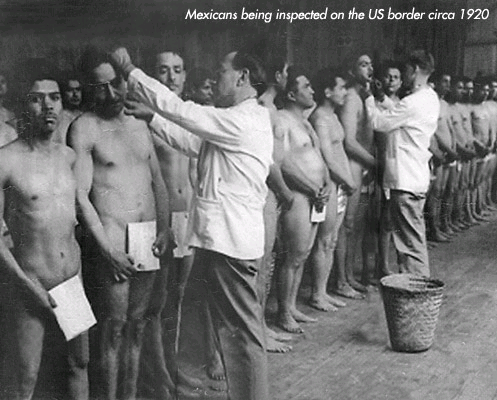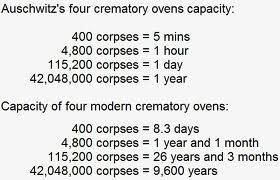
Crematoriums
[back]
Holocaust
revisionism
[With the crematories at Birkenau (Auschwitz II) it would only have been possible to cremate a maximum of 184 bodies a day (see: Ivan Lagace) which is the designed number to account for a typhus epidemic (Hilberg claimed the daily capacity was 4,400). In the typhus epidemic in the summer of 1942, which caused decimation in the Auschwitz-Birkenau camp from 1 to 19 August, 4,113 deaths were registered, on the average 216 per day.1 Also aerial shots show no coal transportation system of any kind and not enough coke to cremate more than 100 corpses a day 1. ]
See: Typhus Ivan Lagace Olga Lengyel
[2011 Nov pdf] Smith's Report 186 Were Jewish Corpses Cremated With a Mere 3.5 kg of Coke? Yes, According to “Holocaust” Science
Book
[1994]
Auschwitz: The End of a Legend by Carlo Mattogno.
Technology reveals the material impossibility of mass extermination
at Auschwitz-Birkenau.

Quotes
Auschwitz-Birkenau: 40 tons of coal/day, at 30 kg (66 lbs) of
coal/body, would have been needed to cremate 1,400 bodies a day. Had no coal
piles or storage yards next to the rail lines (1) or in yards (2) next to
cremation buildings. Had no coal transportation
system of any kind.--11 'Eye-Witness' Stories
Contradicted by Air Photos
....Burg testified that he spoke to hundreds of
people who serviced and operated the crematoria but the people who operated gas
chambers were impossible to find. Nobody had published anything in which it was
claimed that he worked in a gassing institution for human beings. There was
literature about gassing that was completely contradictory. Why? Because it was
all made up. These opinions were published in his books. (25-6840)
....In every camp there were crematoria. It was a practical issue. People died.
When the Germans occupied the eastern territories, the huge camps were
established and there were larger and more crematoria as the war progressed.
Epidemics broke out causing an increased number of deaths. The question of
crematoria was one of hygiene: the process was more hygienic than burial and
took less space. (26-6897, 6898)
....Like all other activities in the camp, the inmates looked after the
crematoria. It was the most difficult work because of the heat and the lifting
of corpses into the ovens. The inmates worked very often in three shifts around
the clock. (26-6998) These workers did it voluntarily. They were asked by the
Jewish council or the Jewish police. It was important to ask how the Jewish
council or police co-operated with the German SS. (26-6900)
[Joseph G. Burg] The 'False News' Trial of Ernst
Zündel -- 1988
Rudolph told Zündel that to cremate anyone took two hours. Thus, to cremate 6 million people in 16 ovens working 12 hours a day would take 171 years. No crematory could work 24 hours a day for even three months. After three months they would collapse because of the internal temperature of 1,200 degrees Celsius required to burn the human body. Rudolph told Zündel that the extermination allegation was technically impossible. At first, Zündel was skeptical. He attempted to find out if Rudolph had made any errors but there were none. [Tijudar Rudolph] The 'False News' Trial of Ernst Zündel -- 1988
Lagacé was asked to comment on the claims made by Raul Hilberg in The
Destruction of the European Jews (2nd ed., page 978) with respect to the
capacities of the 46 retorts in the four crematories at Birkenau. Hilberg
claimed: "The theoretical daily capacity of the
four Birkenau crematoria was somewhat over 4,400, but, with breakdowns and
slowdowns, the practical limit was almost always lower."
Lagacé stated that this claim was
"preposterous" and "beyond the realm of reality." To claim that 46 retorts could
cremate over 4,400 bodies in a day was "ludicrous." Based on his own experience,
Lagacé testified that it would only have been possible to cremate a maximum of
184 bodies a day at Birkenau.
[Ivan Lagacé]
The 'False News' Trial of Ernst Zündel -- 1988
The average life expectancy of floor refractory was 1,500 cremations. The
bricks of the retort's walls and ceilings were rated for 3,000 cremations while
the bricks of the afterburn chamber were rated for roughly 2,000 cremations.
(27-7411)
The time to cremate a human being
(the cremation cycle) took an average of two hours. After the first cremation of
the day was completed, the operator must let the retort cool-down for a minimum
of one hour before beginning the second case. After the second cremation, a
cool- down period of at least two hours was required. Even with cool-down times,
Lagacé testified that cremations could not be done "24 hours a day, round the
clock, day after day...the refractory will not tolerate it." Factory
recommendation for normal operation was a maximum of three cases per day in a
normal eight hour work day. No more than 50 - 60 cases should be processed in
any month so that the refractory life was prolonged. That was an average of 2
cases a day.
There was no way to speed up this
process, Lagacé testified, without effecting the refractory brick and
endangering the life of the operator. If no cool-down period was allowed between
cremations, the temperature would go out of control and probably exceed the
2,200 degrees Fahrenheit rated for the bricks.
[Ivan Lagacé]
The 'False News' Trial of Ernst Zündel -- 1988
Lagacé testified that the plans for the Birkenau crematory indicated that it
had been built to almost the exact specifications of the Bow Valley Crematorium.
Using an overhead of the Birkenau plan, Lagacé pointed out the crematory's
cremation chamber, the flame port, the smoke channel and settling chamber and
the afterburner. He testified that it was obvious that the Germans were
concerned with environmental effects. (27-7430)
Lagacé found the most amazing and
unique part of the Birkenau crematory to be the stack, calculated to be 45 feet
high, and therefore very similar to Bow Valley Crematorium's stack. In Lagacé's
opinion, the rate of burn of the Birkenau unit would be as efficient but not
more than his own unit in Calgary. (27-7432)
The only technology difference that
Lagacé could see between his own crematory and those of Birkenau was the burner
section. Lagacé's crematory used a natural gas burner while Birkenau used a
stoking system with coal or something of a similar nature. The technology of
Lagacé's crematory allowed him to shut the gas off for cooling. Coal was very
cumbersome in that regard and this would affect the time limit since the
operator could not go through a cooling cycle as quickly. (27-7450)
Lagacé was shown a photograph of
one of the Birkenau crematories taken during the war and asked if the units
looked familiar to his own crematory. Lagacé agreed that they were. He
indicated, however, that the Birkenau retorts had been built in units of three
with common walls between them. This would have eliminated the need for extra
bricks and been much easier and quicker to construct. However, he noted, "should
one of these need to be maintained or need any repairs, it would necessitate the
shutdown of the other two [retorts]...attached to it, because you can't have
temperatures of 2,000 degrees radiating into an area where you're working on
another retort."
Lagacé believed that this design
would never be used in a modern crematory simply because, as a business, it
could not afford to have a shutdown of three units if one broke down.
[Ivan Lagacé]
The 'False News' Trial of Ernst Zündel -- 1988
Decomposition of Corpses and Handling of Typhus Infected Corpses:
Lagacé testified that there would be a problem with decomposition if bodies were
left for a period of one to two days. Upon death, the body's defence systems
shut down, leaving any bacteria or viruses in the body "a free rein to wreak
their havoc." There was a rise in the body temperature and gasses began to be
produced. Within hours to a day, bloating caused by tissue gas would cause, for
example, a leg to quadruple in its size. It would be an extremely unpleasant and
dangerous situation if contagious diseases were involved. Tissue gas was highly
contagious and adhered to any equipment such as the floor, the tables, any
instruments used on the bodies. (27-7443, 7444)
Lagacé described the procedures
enforced by the Alberta government in the case of corpses infected with typhus.
At his discretion, the medical officer of health may step in before the body is
even removed from the hospital and specify and order the funeral home to follow
certain procedures in dealing with the body. These included the wearing of
protective clothing when handling the remains, the destruction of that clothing
and the containers that the body was placed in. In a case of typhus, the medical
officer would likely order a direct cremation as this was the most effective way
of dealing with something that volatile. If the body was buried, it had to be
encased in a hermetically sealed container which would last over a prolonged
period of time and only when the soil conditions allowed this, in order to avoid
contamination of the water-table or underground streams. (27-7444, 7445)
[Ivan Lagacé]
The 'False News' Trial of Ernst Zündel -- 1988
Museum officials eventually admitted to Felderer that the entire "gas chamber" at Auschwitz I was rebuilt in various stages to "help" tourists understand what occurred. (18-4298) Felderer concluded that there had never been any gas chamber at Auschwitz I and that the building had been nothing more than a crematory and morgue, later altered in 1943 to an air-raid shelter with a surgical room. Felderer advised Zündel of his conclusions. (19-4356) [Ditlieb Felderer] The 'False News' Trial of Ernst Zündel -- 1988
In this private collection, Felderer was astonished to discover that the cremations carried out at Auschwitz were done in a manner no different than was done in Sweden today. The body to be cremated was identified by a numbered tag placed on the body before cremation. After cremation, the ashes were placed in a plastic bag and the tag tied to the bag. The bag was then placed in an urn and either placed in a wooden casket or mailed to next-of-kin. Felderer showed slides of the bags, urns and tags held in the private collection. These were shown to Felderer and the procedure explained to him by Dr. Szymanski. (18-4318, 4319) [Ditlieb Felderer] The 'False News' Trial of Ernst Zündel -- 1988
"In order to put a stop to the epidemics, we were forced to burn the bodies
of incalculable numbers of people who been destroyed by disease. We were
therefore forced to build crematoria, and on this account they are knotting a
noose for us."
- Reichsführer-SS Heinrich Himmler quoted in: Arthur Butz, The Hoax of the
Twentieth Century (California: Institute for Historical Review, 1985), p.240.
See also: Gerald Reitlinger, The Final Solution (London: Jason Aronson, 1987),
p.480. Nazi Testimony
Lagacé was referred to page 17 of Did Six Million Really Die? where Harwood
stated:
"Although Reitlinger's 6,000 a day would mean a total by October 1944 of
over 5 million, all such estimates pale before the wild fantasies of Olga
Lengyel in her book Five Chimneys (London, 1959). Claiming to be a former inmate
of Auschwitz, she asserts that the camp cremated no less than "720 per hour, or
17,280 corpses per twenty-four hour shift." She also alleges that, in addition,
8,000 people were burned every day in the "death-pits", and that therefore "In
round numbers, about 24,000 corpses were handled every day" (p. 80- 1). This, of
course, would mean a yearly rate of over 8-1/2 million. Thus between March 1942
and October 1944 Auschwitz would finally have disposed of over 21 million
people, six million more than the entire world Jewish population. Comment is
superfluous."
Lagacé testified that from his own experience in
cremating approximately 1,000 bodies, the figures cited by Reitlinger and
Lengyel were not realistic. The person citing such figures, he said, was,
"irresponsible... with his facts because this doesn't even begin to enter
reality at all. It's just physically unrealistic." Lagacé said that even with
present disaster plans, which provide for massive mobilization and the handling
of large numbers of human remains, it would be "unimaginable" to cremate such
numbers. (27-7447)
Lagacé referred to the 1985 issue of a statistical
sheet compiled yearly by the Cremation Association of North America, showing the
numbers of retorts located on the continent and the number of cremations done
annually. The statistics indicated that in 1985, there were a total of 338,370
bodies cremated in 931 crematories in North America. In Canada alone, a total of
49,216 cremations were performed in 94 crematories. (27-7432, 7433, 7434)
[Ivan Lagacé]
The 'False News' Trial of Ernst Zündel -- 1988
Cremation Expert
Crematoriums and delousing chamber at Ellis Island
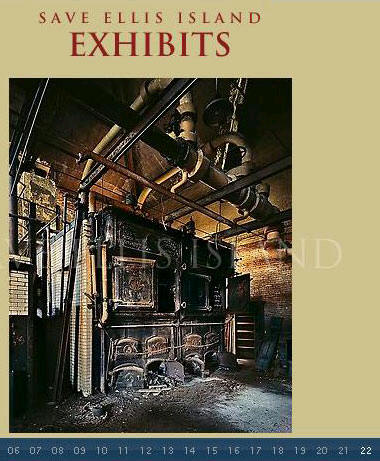
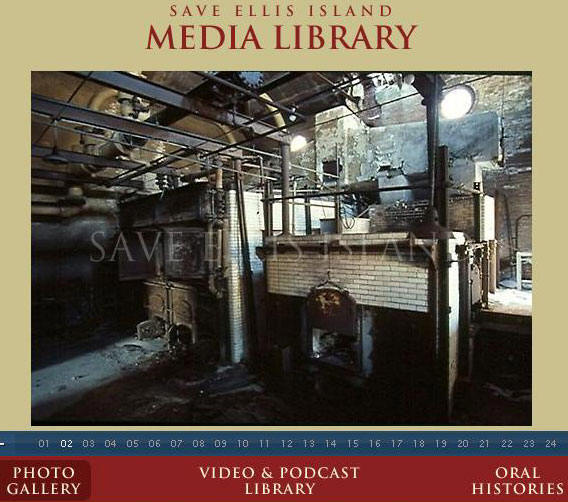
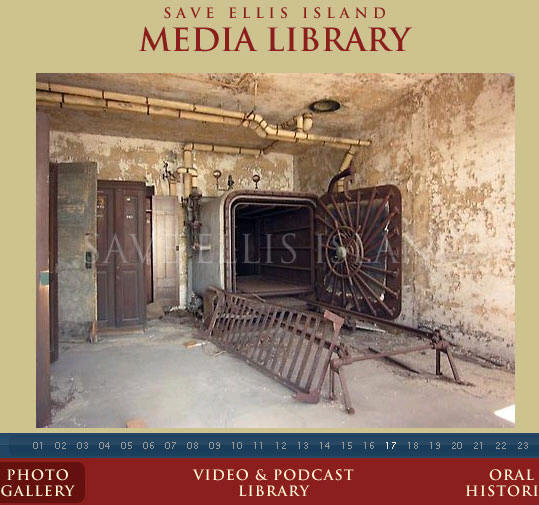
The above images are all from Ellis Island as it can be seen today, albeit only with special permission since what actually occurred in the southern part of the island, the quarantine area, is generally taboo. Ordinary tourists are NOT allowed to see these areas yet, and may never see them. Although tens of millions of dollars have been raised and spent for Ellis Island's restoration generally, the money to “restore” these areas of Ellis Island seems unavailable. The images are from the “laundry building” which also had a huge brick chimney (far larger than needed for any laundry). The images appear on the “Save Ellis Island” website. Although there are no identifying captions for these images, the image on the extreme left looks like a large crematory oven to perform at least two cremations at a time. The middle image shows what also looks like a crematory oven (on the left) for two cremations at a time. The image on the right is a typical autoclave for sanitizing laundry just as at Birkenau's “sauna” and elsewhere. If one had mislabeled these images as “images of Auschwitz,” few people would have any doubt that the images represented something “horrific” or “evil.” http://www.nazigassings.com/
